Data & Research
This information collection is for activities associated with SNAP demonstration projects and the SNAP State Options Report, respectively.
This memo provides State agencies with guidance on allowable use of advanced automation technologies.
Applications Now Open for States to Streamline Access to Free, Reduced Price School Meals
Did you know there’s a way for children in Medicaid households to be automatically eligible for free and reduced price school meals without their families completing another application? It’s called the Direct Certification with Medicaid Demonstration Project and USDA recently opened applications for more states to participate.
Currently, 38 states participate in the demonstration project, which represents 91% of the nation’s K-12 students. In school year 2019-20, these demonstration projects allowed states to directly certify more than 1.4 million students for free and reduced price meals based on Medicaid data.
New states will have the opportunity to start this project in school years 2024-25, 2025-26, or 2026-27. USDA will consider applications received through Nov. 30, 2025.
Automatic eligibility is a win-win for students, families, and school officials because it provides benefits such as:
- Lower food costs for families,
- Lower school meal debt,
- Higher student participation in school breakfast and lunch programs, and
- Less time and administrative burden for hardworking school nutrition staff.
Arizona, for example, began participating in the Direct Certification with Medicaid Demonstration Project this school year (2023-24) and is experiencing positive results from it. According to Tom Horne, the state’s superintendent of public instruction with the Department of Education, the pilot has already benefited thousands of additional Arizona students who now can receive breakfasts and lunches free of charge each school day, and their families no longer need to fill out an application.
Direct Certification with Medicaid will also give more kids access to USDA’s new Summer Electronic Benefits Transfer program, also known as Summer EBT, which will launch in summer 2024. Households with students who are automatically eligible for free school meals will also be automatically eligible to receive $40 per summer month (per child) in grocery benefits if they live in states, territories, and Tribal Nations that participate in Summer EBT.
Children are also automatically eligible for free and reduced-price school meals – and Summer EBT benefits – if they live in households that participate in other income-based federal assistance programs, such as the Supplemental Nutrition Assistance Program, also known as SNAP.
More information about the Direct Certification for Medicaid Demonstration Project is available on the FNS website.
FNS is conducting additional demonstration projects to expand the evaluation of direct certification with Medicaid for both free and reduced price meal eligibility in NSLP and SBP.
FDPIR Self-Determination Demonstration Project
The 2018 Farm Bill authorized USDA to establish a demonstration project for one or more tribal organizations administering the Food Distribution Program on Indian Reservations (FDPIR) to enter into self-determination contracts as defined in section 4 of the Indian Self-Determination and Education Assistance Act, to purchase USDA Foods for the FDPIR food package for their tribe.
Under normal program operations, all USDA Foods provided in the FDPIR food package are purchased and provided by USDA. Through this demonstration project, participating tribes are able to:
- select one or more foods that they would like to procure for inclusion in the food package,
- identify the food(s) in the food package that they would like to supplant with the tribally procured food(s),
- establish contract(s) with a vendor(s) to procure the selected food(s), and
- distribute the tribally procured food(s) alongside other USDA-provided foods in the FDPIR food packages distributed to their tribal members.
There are a few requirements associated with the tribally procured foods, including that they are domestically sourced and that they are of similar or higher nutritional value as the food(s) being replaced.
The demonstration project:
- supports tribal self-governance by allowing participating tribes to purchase similar foods of their choosing, supporting tribal dietary preferences;
- allows tribes to purchase foods through commercial vendors of their choice;
- supports tribal economies as tribes may choose to contract with local, regional, and/or tribal vendors; and
- provides FNS with an opportunity to see how tribal procurement may work under a food distribution program model across region, program size, and food selection.
The map below highlights tribes currently participating in the demonstration project:

Round 2 Projects
USDA awarded $4.4 million dollars to tribal nations participating in round 2 of the demonstration project. Project implementation began in August 2023 with some contracts expected to last up to three years, through 2026. More information on each tribe's project is outlined below.
- Cherokee Nation
Tribally Procured Foods beef chuck roast, ground beef chubs USDA Supplanted Foods beef chuck roast, ground beef chubs Vendors 1839 Cherokee Meat Company (Native vendor) Distribution Months 36 months 

- Confederated Tribes of the Umatilla Indian Reservation
Tribally Procured Foods ground beef, beef chuck roast, celery, lettuce, cabbage, carrot, squash, cucumber, honey dew melon, peaches, oranges, apples, cherries, apricots, eggs USDA Supplanted Foods ground beef, beef chuck roast, celery, lettuce, cabbage, carrot, squash, cucumber, cantaloupe, peaches, Crenshaw melon, apples, cherries, apricots, eggs Vendors Hines Meat Company, Yakama Nation Farms (Native vendor), Rez Chicks Fresh Eggs Cooperative (Native vendor) Distribution Months 36 months - Gila River Indian Community
Tribally Procured Foods tepary beans USDA Supplanted Foods dry beans Vendors Ramona Farms (Native vendor) Distribution Months 14 months - Quinault Indian Nation
Tribally Procured Foods canned albacore tuna, canned Coho salmon, canned King salmon, King salmon fillet, razor clams, ling cod, rock fish USDA Supplanted Foods chunk light tuna, canned chicken, canned beef, frozen salmon, bison, walleye, whole frozen chicken, catfish Vendors Quinault Pride Seafood (Native vendor) Distribution Months 36 months - Sokaogon Chippewa Community
Tribally Procured Foods wild rice, carrots, cauliflower, pickling and slicing cucumbers, sweet corn, roma and slicing tomatoes, zucchini, bison burger, ground beef, pork chops, chicken breast USDA Supplanted Foods wild rice, carrots, cauliflower, cucumbers, sweet corn, tomatoes, zucchini, bison burger, ground beef, pork chops, chicken breast Vendors Forest County Potawatomi's Bodewewadmi Ktegan Farm (Native vendor), Carson Ackley, Wild Rice Harvester (Native vendor), James Polar, Sr., Wild Rice Harvester (Native vendor) Distribution Months 36 months - Spirit Lake Tribe
Tribally Procured Foods bison USDA Supplanted Foods bison Vendors North American Bison, LLC Distribution Months 36 months Beginning Oct. 2023, Spirit Lake Tribe will be offering a variety of tribally procured bison products to their participants as part of their FDPIR Self-Determination Demonstration Project. The products include: bison dogs, bison ribeye, bison sirloin steak tips, and bison burgers.
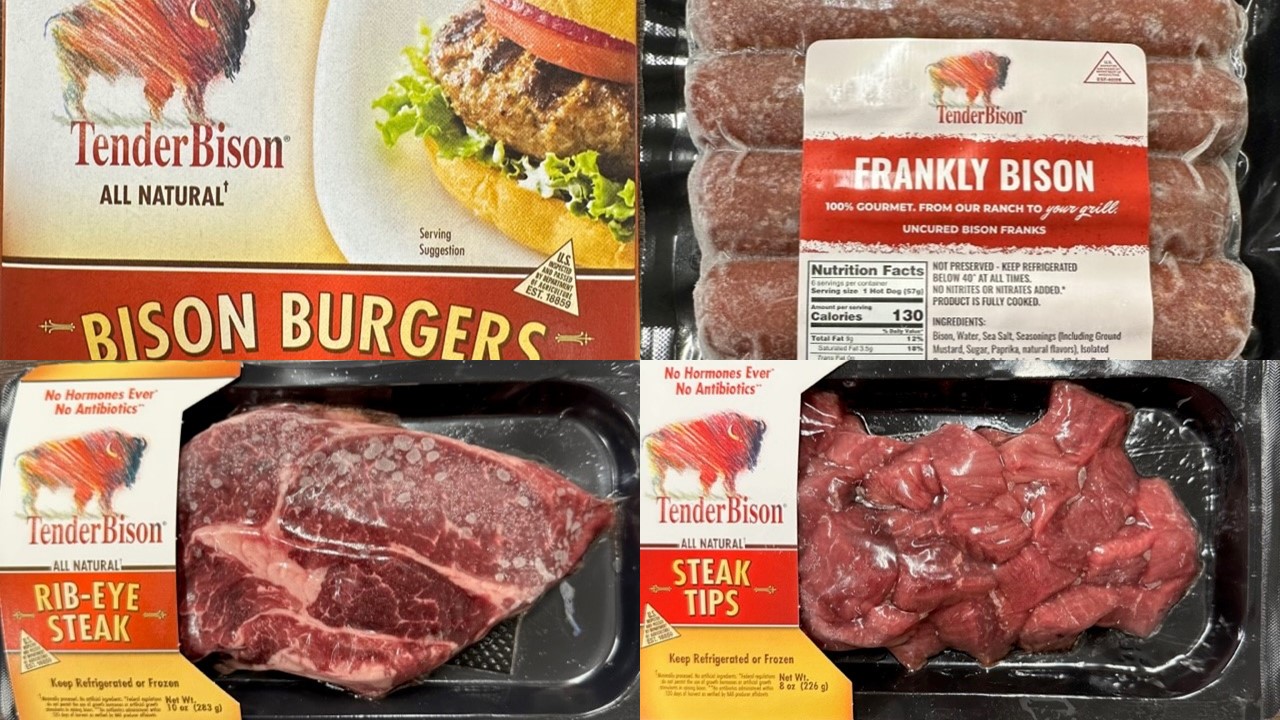
Photo credit: Spirit Lake Tribe - Tohono O'odham Nation
Tribally Procured Foods soft wheat berries (various), hard wheat berries, wheat flour (various), white tepary beans, brown tepary beans, garbanzo beans USDA Supplanted Foods dehydrated potatoes, cherry apple juice, corn flakes cereal, all-purpose flour, egg noodles, canned pinto beans, dry pinto beans, cream of chicken soup Vendors Ramona Farms (Native vendor), San Xavier Cooperative Farm (Native vendor) Distribution Months 36 months - White Mountain Apache Tribe
Tribally Procured Foods barbecue corn, corn, summer squash, patty pan squash, green chilies, blue corn meal, ground beef, tongue, intestines, steak, liver, sweet bread, walnuts, acorns, pine nuts USDA Supplanted Foods canned corn, fresh corn, squash, canned carrots, jalapenos, yellow corn meal, ground beef, bison, chicken, roast beef, canned chicken, canned beef, peanuts, peanut butter, and fruit and nut mix Vendors Ndee Bikiyaa Farm (Native vendor), SPO Land and Cattle Co. Distribution Months 36 months
Round 1 Projects
USDA has awarded $5.7 million dollars to tribal nations participating in round 1 of the demonstration project. Project implementation began in October 2021 with some contracts expected to last up to three years, through 2024. More information on each tribe's project is outlined below.
- Oneida Nation and Menominee Indian Tribe of Wisconsin (joint project)
Tribally Procured Foods ground beef, bison, beef roast, apples, white fish/lake trout, wild rice, walleye USDA Supplanted Foods ground beef, bison, beef roast, apples, catfish/salmon, wild rice, walleye Vendors Oneida Nation Farm, Oneida Nation Apple Orchard, Red Cliff Fish Company, and Spirit Lake Native Farms Distribution Months 6 - 24 months A video showcasing the Oneida Nation - Menominee Indian Tribe of Wisconsin, self-determination demonstration project, and the many benefits the project is bringing to tribal members. Video production credit: The Self-Governance Communication & Education Tribal Consortium (SGCETC).

Wild rice from Spirit Lake Native Farms. The Oneida Nation and Menominee Indian Tribe of Wisconsin are partnering on a joint self-determination demonstration project that will provide tribally procured ground beef, bison, beef roast, white fish, lake trout, apples, and wild rice to their FDPIR participants.

- Little Traverse Bay Bands of Odawa Indians (LTBB)
Tribally Procured Foods all fresh produce, walleye USDA Supplanted Foods all fresh produce, walleye Vendors Red Lake Nation Fishery Distribution Months 24 months Jake Robinson (right), General Manager of Red Lake Nation Fishery, delivers walleye fillets to Joe Van Alstine (left), FDPIR Program Director for the Little Traverse Bay Bands of Odawa Indians. Red Lake Nation Fishery is located in Redby, Minnesota, and is owned and operated by Red Lake Nation.

Photo credit: Jo Van Alstine. - Red Cliff Band of Lake Superior Chippewa
Tribally Procured Foods frozen white fish, carrots, potatoes of various colors, cucumbers, romaine/butterhead/green leaf lettuce, frozen squash, apples, fresh and frozen blueberries, wild rice, tomatoes, onions, summer squash, radishes, cherry tomatoes, winter squash, salad mix, smoked fish USDA Supplanted Foods salmon, carrots, red potatoes, cucumbers, romaine lettuce, canned vegetables, apples, frozen blueberries, wild rice, tomatoes, onions, summer squash, radishes, cherry tomatoes, winter squash, canned fish Vendors Dynamite Hill Farms, Highland Hill Farms, Red Cliff Fish Company, and Mino Bimaadiziiwin Tribal Farm Distribution Months 31 months Program Contact Vincent "Butch" Bresette
Butch.bresette@redcliff-nsn.gov
(715) 779-3740The Mino Bimaadiziiwin Farm, which is owned and operated by The Red Cliff Band of Lake Superior Chippewa, provides fresh produce to FDPIR participants through the demonstration project. Produce items provided by the farm for the project include everything from carrots and squash to lettuce and salad mix.
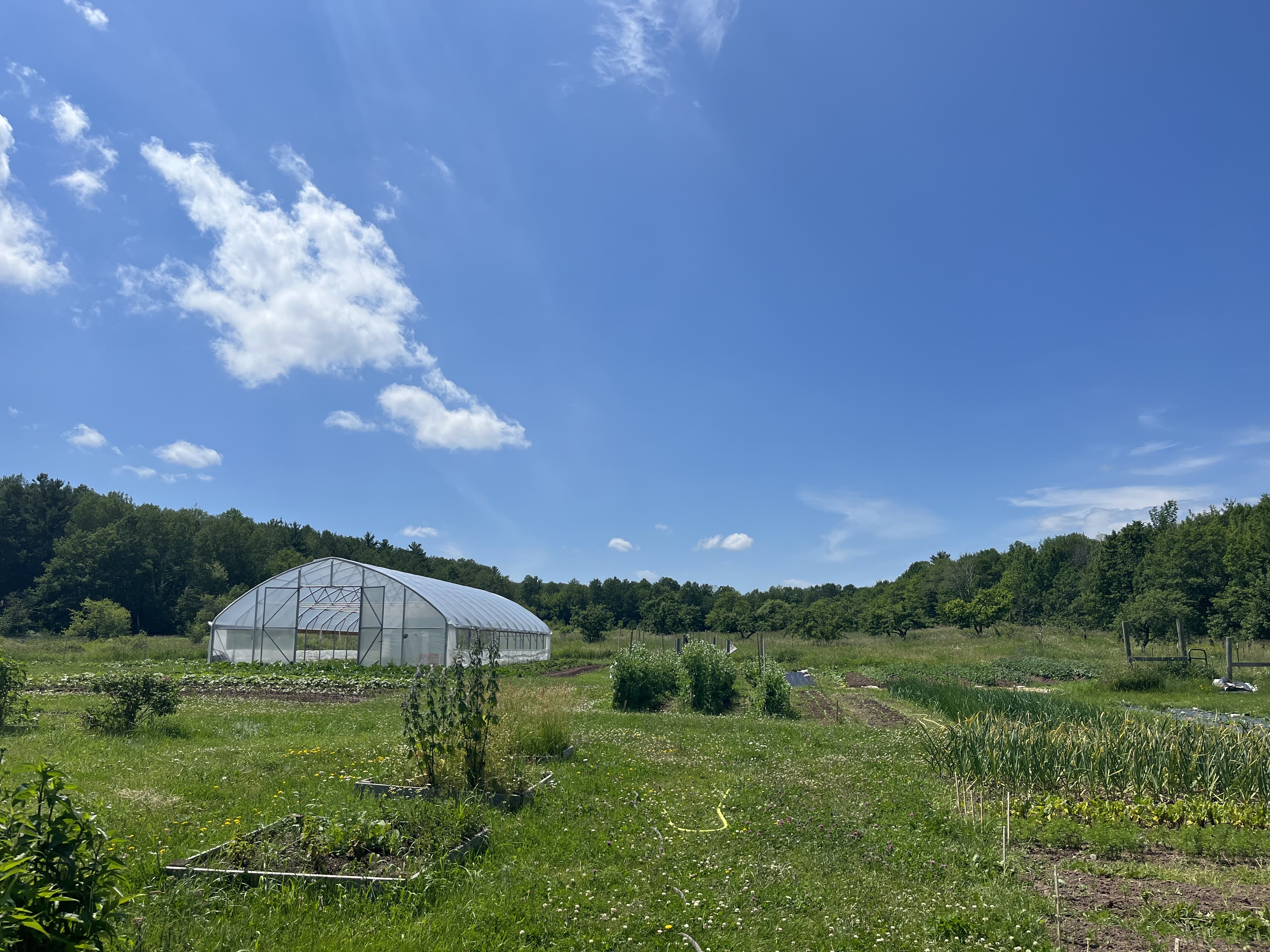
Photo credit: Mino Bimaadiziiwin Tribal Farm. The Red Cliff Fish Company is located within the Red Cliff Reservation, which spans 22 miles of Lake Superior shoreline in northern Wisconsin. Through the FDPIR self-determination demonstration project, Red Cliff Fish Company will provide fish products to FDPIR participants in The Red Cliff Band of Lake Superior Chippewa, the Oneida Nation, and the Menominee Indian Tribe of Wisconsin.
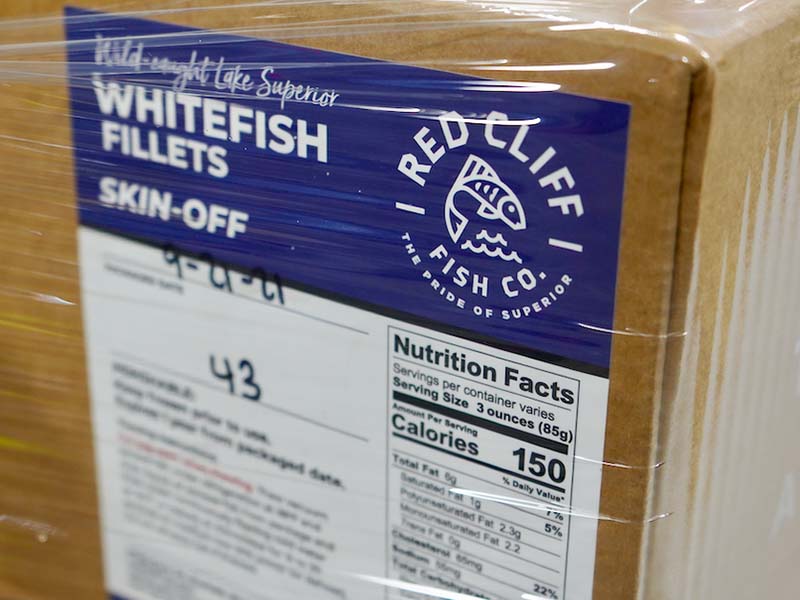
Photo credit: Daniel Cornelius. Check out the project photo gallery.
- Chickasaw Nation
Tribally Procured Foods ground beef, roast beef, dry hominy, stew meat, pecans USDA Supplanted Foods ground beef, roast beef, wild rice, canned beef, peanuts Vendors Rolland Ranch Beef, Guderian Foods, and Bryant Pecan Company Distribution Months 24 - 33 months Ground beef from Rolland Ranch Beef, LLC. The Chickasaw Nation is utilizing FDPIR self-determination contract funding to purchase both ground beef and roast beef from Rolland Ranch Beef, LLC., a tribally-owned and family-operated ranch in Checotah, Oklahoma.
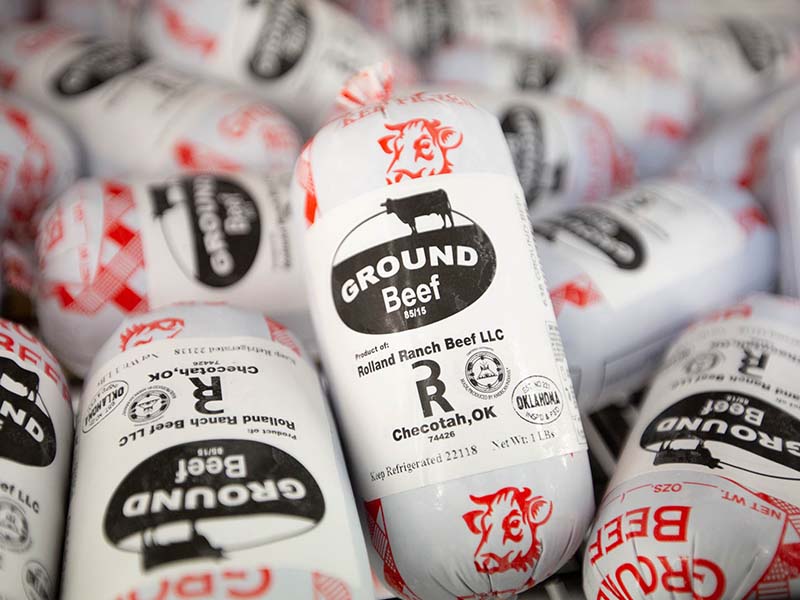
Photo credit: Chickasaw Nation. Beef products from a local tribal producer at a Chickasaw Nation food distribution warehouse. Through the demonstration project, Chickasaw Nation is purchasing a variety of tribally-produced foods for the FDPIR food packages distributed to their tribal members. These products include ground beef, roast beef, dry hominy, stew meat, and pecans.
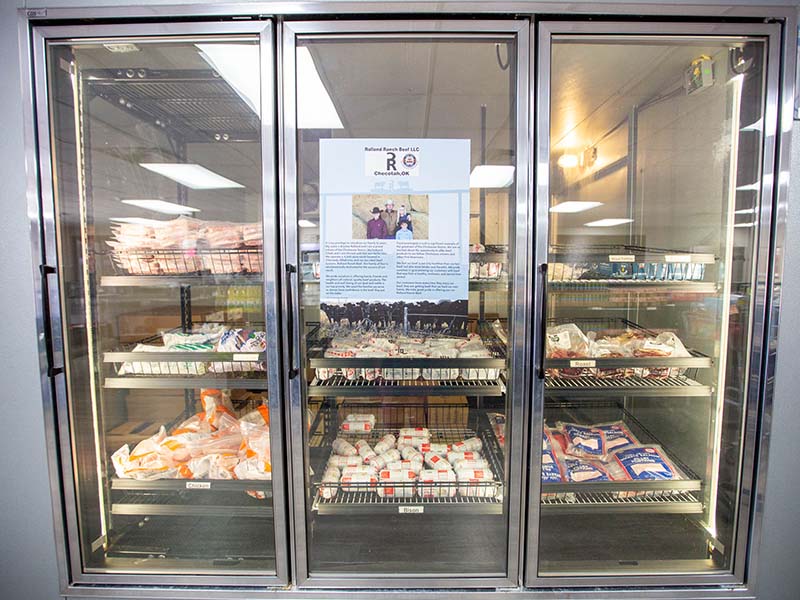
Photo credit: Chickasaw Nation. - Alaska Native Tribal Health Consortium (ANTHC)
Tribally Procured Foods Alaskan halibut, cod, Alaska grown potato USDA Supplanted Foods catfish, walleye, russet potato Vendors Kodiak Island WildSource and Knik Tribe Distribution Months 14 - 28 months Project Contact Dana Diehl
ANTHC Director, Wellness and Prevention
info.fdpir@anthc.org
(907) 729-2440The Alaska Native Health Consortium, known as ANTHC, operates a FDPIR self-determination demonstration project that provides foods to 18 tribes across Alaska. Learn more about the ANTHC project in this video.
Healthy potato plants growing at the Knik Tribe farm near Palmer, Alaska. Beginning in fall/winter 2022, the Alaska Native Tribal Health Consortium will purchase potatoes from the farm with FDPIR self-determination contract funds.

Gregory Nothstine (center), FDPIR Program Director for the Alaska Native Tribal Health Consortium (ANTHC), and Mike Reusser (left) and Jim Baldwin (right) of the Food Bank of Alaska (FBA), receive a first shipment of Alaskan halibut at the FBA warehouse in Anchorage, Alaska. ANTHC purchases the fish with self-determination contract funds and then works with FBA to ship the product (along with other FDPIR foods) to 21 tribal villages throughout the state.

Photo credit: Food Bank of Alaska. Barbara Lopez (FNS Senior Technical Advisor for Supplemental Nutrition and Safety Programs), Gregory Nothstine (FDPIR Program Director for the Alaska Native Tribal Health Consortium (ANTHC)), and Dana Diehl (Director of the Wellness and Prevention Department at ANTHC), in front of the Kodiak Harbor in Kodiak, Alaska. Fresh Alaskan cod and halibut for the demonstration project are fished out of the harbor and processed by Kodiak Island Wildsource, a business owned and operated by the Sun'aq Tribe of Kodiak, before being shipped to FDPIR participants across Alaska.
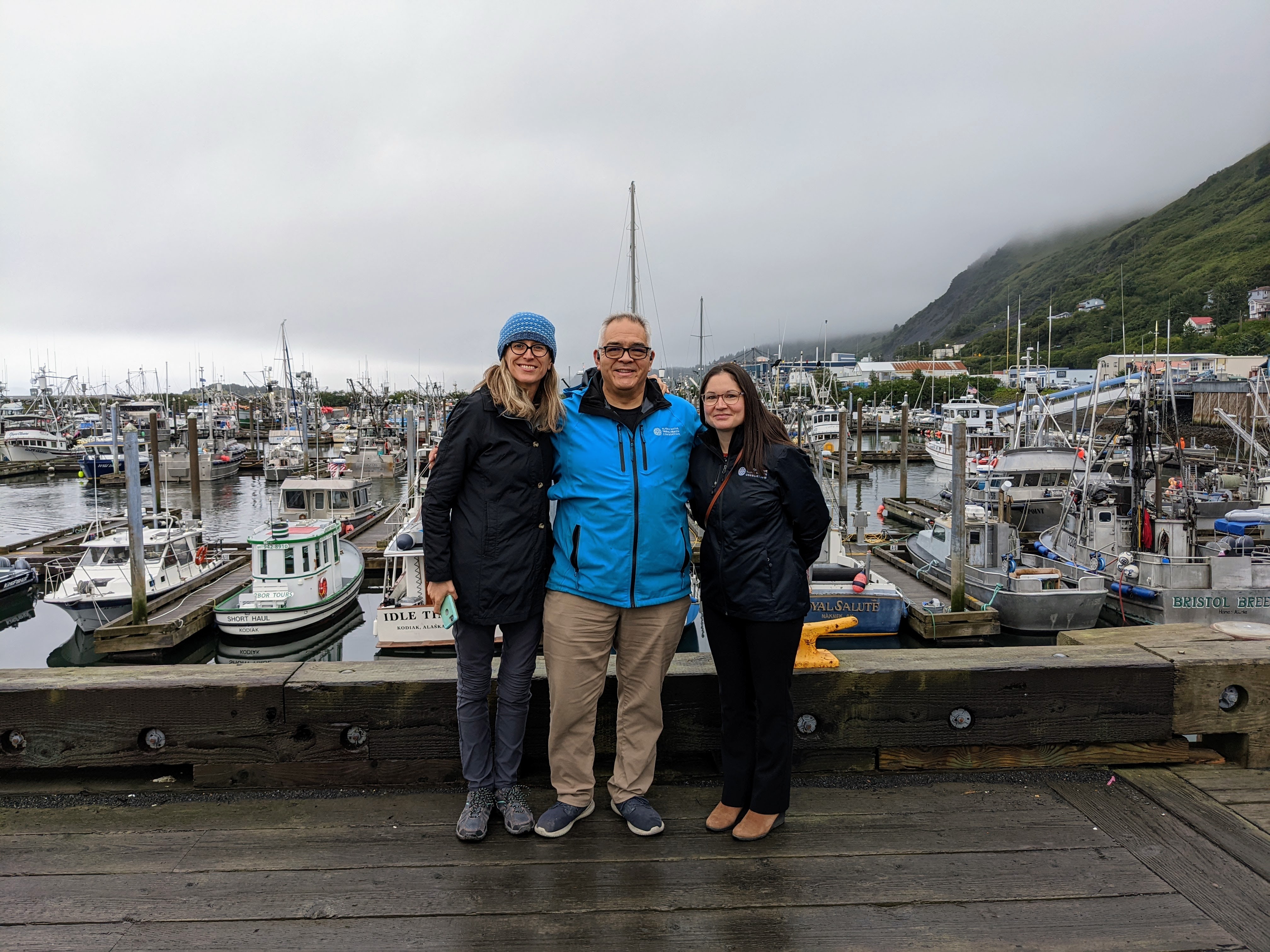
- Lummi Nation
Tribally Procured Foods salmon, halibut, prawns/shrimp, crab USDA Supplanted Foods catfish, walleye Vendors Nexwelhqeyem Seafood, LLC and Finkbonner Shellfish Distribution Months six months or more Lummi Nation Commodity Foods staff proudly display frozen sockeye salmon fillets purchased with FDPIR self-determination contract funds. Lummi Nation manages several treaty-reserved fisheries off the Washington coast and will be providing a variety of local seafood items to FDPIR participants through the demonstration project.
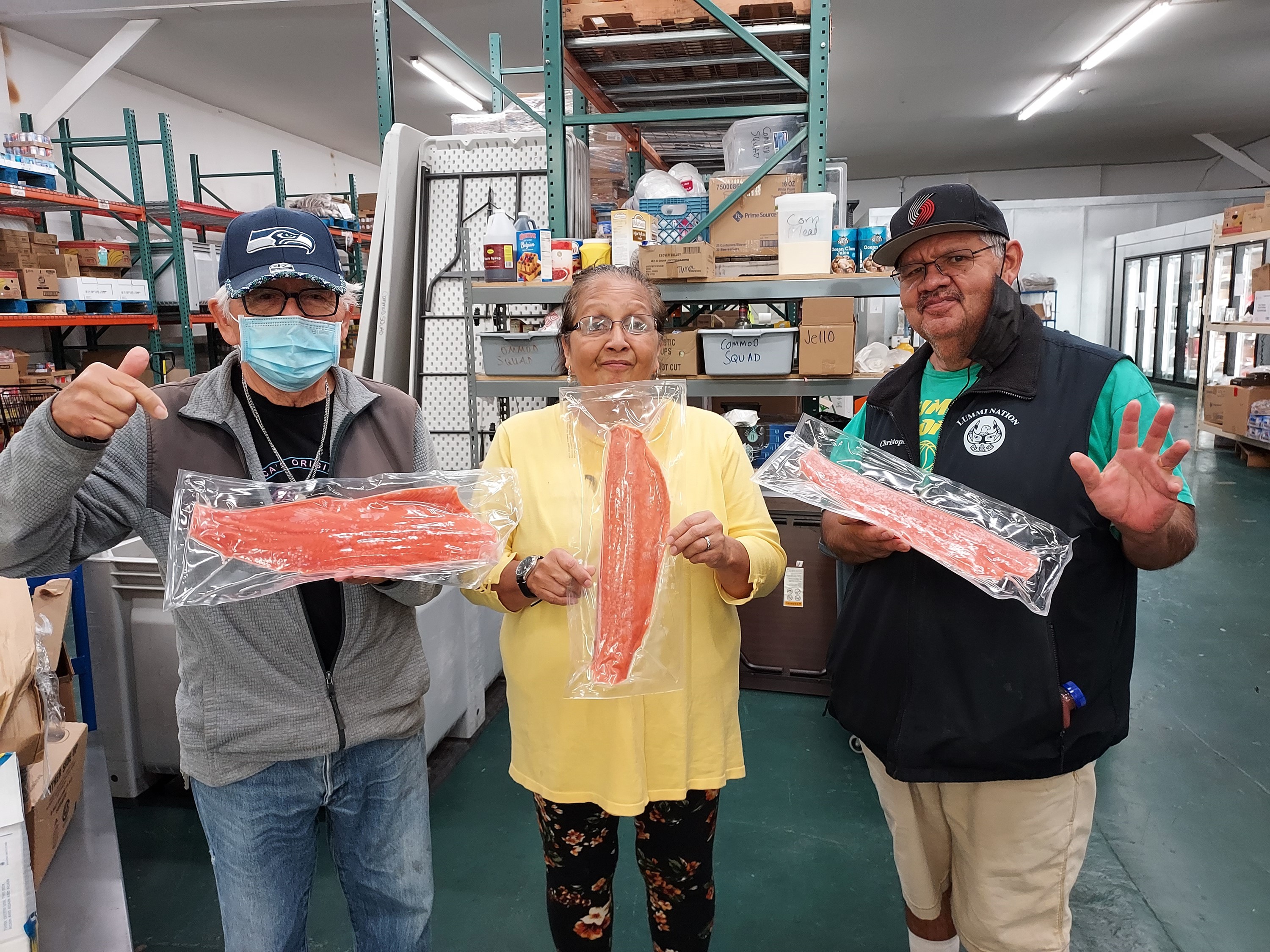
Photo credit: Lummi Nation Commodity Foods. Check out the project photo gallery!
- Mississippi Band of Choctaw Indians (MBCI)
Tribally Procured Foods turnip greens, collard greens, yellow squash, red/green tomatoes, tomato berries, bell peppers, hot/sweet peppers, cucumbers USDA Supplanted Foods romaine lettuce, summer squash, tomatoes, cherry tomatoes, green pepper, cucumbers Vendors Choctaw Fresh Produce Distribution Months 36 months An employee of Choctaw Fresh shows off some fresh collard greens that will be put into FDPIR food packages for eligible tribal members. The Mississippi Band of Choctaw Indians is purchasing a variety of fresh vegetables from the Choctaw Fresh Farm, an organic produce farm located on the Mississippi Band of Choctaw Indians Reservation.
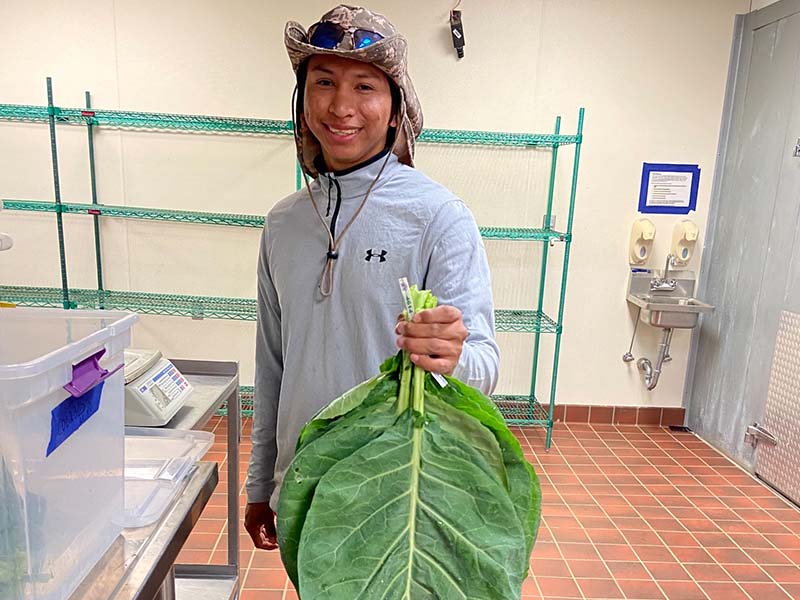
Photo Credit: Choctaw Fresh Farm. Collard green seedlings waiting to be planted in a high tunnel. The Mississippi Band of Choctaw Indians is purchasing turnip greens, collard greens, yellow squash, tomatoes, tomato berries, bell peppers, cucumbers, and a variety of hot and sweet peppers, for FDPIR participants through the FDPIR self-determination demonstration project.
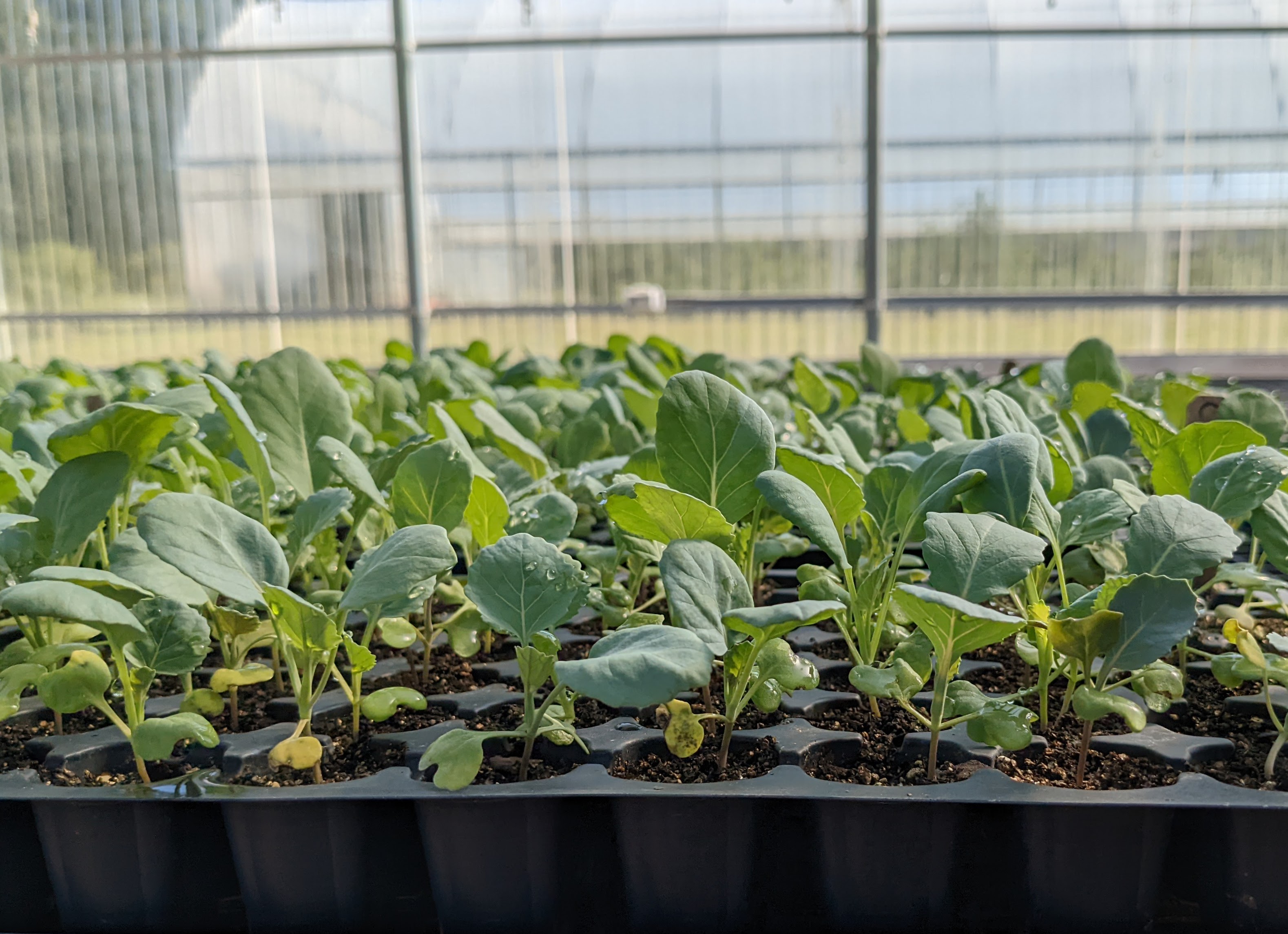
Photo credit: Choctaw Fresh Farm.
Demonstration Project Resources
- Federal Register Documents
- Resources (webinars/FAQs)
- USDA Communications (press releases/blogs)
- FDPIR Sharing Gallery
- USDA Indigenous Food Sovereignty Initiative
The 2018 Farm Bill authorized USDA to establish a demonstration project for one or more tribal organizations administering FDPIR to enter into self-determination contracts to purchase USDA Foods for the FDPIR food package for their tribe.
Summer Food for Children Demonstrations
| On Dec. 23, 2022, Congress authorized Summer EBT as a permanent program. FNS is working with states and local partners to implement this new program. Visit our Summer EBT webpage to learn more. |
In the 2010 Agriculture Appropriations Act (PL 111-80), Congress authorized demonstration projects to develop and test methods of providing access to food for low-income children in urban and rural areas during the summer months when schools are not in regular session, as well as rigorous independent evaluations of each projects’ effectiveness.
The Food and Nutrition Service launched the first of these projects, collectively known as the Summer Food for Children Demonstrations (SFC), in the summer of 2010. Over the years, these demonstration projects have tested multiple approaches to addressing summer food insecurity among children in a variety of settings, and continue to test innovative concepts for summer feeding.
Summer Electronic Benefits for Children (Summer EBT)
2011-Present
Through Summer EBT, participating States and Tribes provide the families of low-income children with food benefits on debit cards, giving them more resources to use at retail food stores during the summer. Summer EBT is designed to complement traditional summer meal programs by providing States with an additional tool to serve communities that have limited or no access to traditional summer meal programs.
For more information about Summer EBT, please visit the Summer EBT webpage.
Meals-To-You
2019-Present
The Meals-To-You Demonstration Project provides nutrition during the summer months to children who may otherwise be unable to access existing Summer Food Service Program sites. Families with students who are eligible for free- or reduced-price meals opt-in to be mailed one box per child per week during the summer. Each box contains components for 15 meals: five breakfasts, five lunches/suppers, and five snacks.
- FNS Blog: Innovation and Collaboration Bring Summer Meals to Children in Rural Texas
- FNS News Release: USDA Highlights Success of Rural Summer Meals Delivery Project in Texas
Demonstration Project for Non-Congregate Feeding for Outdoor Summer Meal Sites Experiencing Excessive Heat
2011-Present
The Demonstration Project for Non-Congregate Feeding for Outdoor Summer Meal Sites Experiencing Excessive Heat allows summer meal programs operating approved outdoor meal service without temperature-controlled alternative sites to operate as non-congregate sites on days when the area is experiencing excessive heat. Non-congregate meal service is permitted only on days when the National Weather Service has issued a Heat Advisory, an Excessive Heat Warning, or an Excessive Heat Watch for the area in which an approved outdoor meal site is located.
Enhanced Summer Food Service Program (eSFSP)
2010-2013
The eSFSP demonstration projects tested multiple methods of improving service delivery through the existing summer meal programs. Demonstrations encouraged sites to operate for a greater portion of the summer, supported recreational or enrichment activities at the sites, delivered meals to eligible children in rural areas, and provided take home backpacks of food to cover the days that SFSP meals were not available.
Documents related to eSFSP:
- Evaluation of the Impact of Incentives Demonstrations on Participation in the Summer Food Service Programs (SFSP): FY 2010 Arkansas and Mississippi
- Evaluation of the Summer Food Service Program Enhancement Demonstrations: 2011 Demonstration Evaluation Report
- Evaluation of the Impact of Enhancement Demonstrations on Participation in the Summer Food Service Program (SFSP): FY 2011
- Evaluation of the Impact of Wave 2 Incentives Demonstrations on Participation in the Summer Food Service Program (SFSP): FY 2012
- Evaluation of the 2012 Summer Food Service Program Enhancement Demonstrations
- Report on the Summer Food for Children Demonstration Projects for Fiscal Year 2013
Documents Related to all SFC Demonstrations
- 2010 Report to Congress (3.06 MB)
- 2011 Report to Congress (267 KB)
- 2012 Report to Congress (237 KB)
- 2013 Report to Congress (261 KB)
Send questions about the Summer Demonstrations to CNDInternet@fns.usda.gov.
On Dec. 23, 2022, Congress authorized Summer EBT as a permanent, nationwide program. FNS is quickly developing more guidance on Summer EBT, and we look forward to working with our partners in states and local communities as we implement this program.
Summer Electronic Benefit Transfer for Children (SEBTC)
|
On Dec. 23, 2022, Congress authorized Summer EBT as a permanent program. FNS is working with states and local partners to implement this new program. Visit our Summer EBT webpage to learn more. |
Previous Demonstrations
As part of its efforts to end child hunger, the USDA Food and Nutrition Service (FNS) created the Summer Electronic Benefits Transfer for Children (SEBTC) demonstration to study the use of SNAP and WIC electronic benefits transfer (EBT) technology in providing food assistance to low-income children during the summer by providing their families with more resources to use at food stores.
- 2011 Proof of Concept Year: Small-scale “proof-of-concept” demonstrations of the EBT-based approaches began in summer 2011 in two states for the WIC model (Michigan and Texas) and three states for the SNAP model (Connecticut, Missouri and Oregon). Each state provided benefits to 2,500 children in summer 2011.
- 2012 Expanded Operations and New Sites: All five proof-of-concept states are increasing operations in summer 2012 to serve 5,000 children in the 2011 demonstration areas. Four of these states (Connecticut, Missouri, Oregon and Michigan) are also serving an additional 5,000 children in new parts of their states.
In addition, five new states and Tribal Organizations will begin implementing SEBTC projects in 2012 each providing 5,000 children with benefits: Cherokee Nation (WIC), Chickasaw Nation (WIC), Nevada (WIC), Delaware (SNAP) and Washington (SNAP).
Documents Related to SEBTC
Summer Electronic Benefit Transfer for Children (SEBTC) Demonstration: A Summary Report
- Report Summary (52 KB)
- Report (2.08 MB)
Summer Electronic Benefits Transfer for Children (SEBTC) Demonstration: Evaluation Findings for the Third Implementation Year: 2013 Final Report
- Report Summary (33 KB)
- Report (3.94 MB)
Summer Electronic Benefits Transfer for Children (SEBTC) Demonstration: Evaluation Findings for the Full Implementation Year 2012 Final Report
- Report Summary (36 KB)
- Report (3.6 MB)
- Appendix (5.5 MB)
Congressional Status Report: Summer Electronic Benefits Transfer for Children Demonstrations, 2012
- Full Report (1.0 MB)
- Appendices (2.2 MB)
Summer Electronic Benefits Transfer for Children (SEBTC): Evaluation Findings for Proof-of-Concept Year - November 2012
- Report Summary (56 KB)
- Entire Report (4.22 MB)
Summer Electronic Benefits Transfer For Children: Early Experiences through June 2011 of the Proof-of-Concept Year
- Report Summary (321 KB)
- Full Report (3.54 MB)
Congressional Status Report: Summer Electronic Benefits Transfer for Children Demonstrations, 2011
- Full Report (1.0 MB)
- Appendices (4.48 MB)
Send questions about the Summer Food for Children Demonstrations to CNDInternet@fns.usda.gov.
On Dec. 23, 2022, Congress authorized Summer EBT as a permanent, nationwide program. FNS is quickly developing more guidance on Summer EBT, and we look forward to working with our partners in states and local communities as we implement this program.
The Summer Food for Children Demonstrations are a series of projects to develop and test methods of providing access to food for low-income children in urban and rural areas during the summer months when schools are not in regular session.
Current Data Collections
This page provides a list of all studies currently, or soon to be, collecting data. For completed studies and their results, please visit Research and Analysis. For study related questions, please contact us at FNSstudies@usda.gov.
SNAP Studies
How Have SNAP State Agencies Shifted Operations in the Aftermath of COVID?
Data Collection Year: Anticipated in 2024
Contractor: Mathematica
When the COVID-19 pandemic began in early spring 2020, many SNAP state agencies had to make significant adjustments to their processes in order to process SNAP applications and issue benefits remotely. States varied in their readiness for remote work but had to adapt rapidly to the new environment. This study seeks to understand how SNAP state agencies have made permanent operational changes since the start of the pandemic and how they have built upon the innovation initiated by the pandemic. Such changes may include: equipment purchases to facilitate additional telework opportunities for employees, including eligibility workers; full-time remote employees; increased use of telephonic or electronic signatures; changes to document storage (i.e. cloud storage); and call center implementation or enhancements. Through a survey all of 53 SNAP state agencies, this study seeks to understand the changes that have occurred in operations and norms since the pandemic and how state agencies have increased their preparedness in the event of another major work disruption
Assessing SNAP Participants’ Fitness for Work
Data Collection Year: Ongoing through fall 2023
Contractor: MEF Associates
SNAP statute requires that SNAP participants between the ages of 16 and 59 register for work or be registered by the state agency, unless they receive a federal exemption. Among the exemptions include being found mentally or physically unfit for employment. States have varying ways of determining if an individual is fit for work. This study seeks to understand how states implement this provision and the challenges they face in providing good customer service to SNAP participants. The study will conduct a review of state policy and guidance related to determining whether individuals are fit for work. The study will also include interviews with SNAP eligibility workers to understand how the policy is interpreted and implemented and the challenges that arise with serving the needs of their clients.
Rapid Cycle Evaluations of Operational Improvements in SNAP E&T
Data Collection Year: Summer of 2023 through Spring of 2024
Contractor: Mathematica
This study provides funding for testing small scale improvements in state SNAP E&T programs. Examples might include improving notices to participants or developing videos to promote E&T providers. States would receive funding to improve the operations of their SNAP E&T programs and an independent evaluator would assess the effectiveness of the innovation over a short-term period, usually a few months. If warranted, a tested intervention may be adjusted based on ongoing or continual evaluation feedback to improve its effectiveness. The evaluator would also provide technical assistance to the states when developing or implementing the operational improvement.
Food Security Status and Well-Being of Nutrition Assistance Program (NAP) Participants in Puerto Rico
Data Collection Year: Ongoing in 2023
Contractor: Westat Insight
The Additional Supplemental Appropriations for Disaster Relief Act, 2019 (PL 116-20) provided funding to conduct an independent study in Puerto Rico to assess the impact of the additional benefits provided to participants in Puerto Rico’s Nutrition Assistance Program (NAP) in the wake of Hurricane Maria. This study will measure food security, health status and well-being among NAP participants at a point in time after the extra disaster benefits were provided. However, there are limitations with a retroactive analysis in attributing any causal impacts to the additional benefits.
Serving SNAP Applicants and Participants with Limited English Proficiency
Data Collection Year: Summer and Fall 2023
Contractor: Mathematica
SNAP state agencies are required to translate materials related to all aspects of program administration (e.g. applications, notices, charge letters, informational documents) into languages other than English to serve the needs of their clients with limited English proficiency (LEP). States also have the opportunity to provide LEP services through their SNAP Education and Training (E&T) programs. FNS has limited information on the breadth (i.e. which languages) and depth (i.e. what types of documents) of how state agencies serve their clients with LEP, or whether they offer LEP services through their SNAP E&T programs. This study will survey all 53 SNAP state agencies to catalog which languages state agencies offer for which types of documents and whether or not they offer LEP services through their SNAP E&T program. The study will ask states how they determine which languages should be offered and how they manage the translation process and if they offer any SNAP E&T LEP services and what services they offer if they do.
Assessment of Mobile Technologies for Using SNAP Benefits
Data Collection Year: 2024 through early 2026
Contractor: Mathematica
The Agricultural Act of 2018 authorizes the use of mobile technologies for the purpose of accessing SNAP benefits. This allows SNAP participants to input their Electronic Benefit Transfer (EBT) card into a mobile technology, such as Apple Pay or Google Pay, and make SNAP purchases at the point-of-sale without the presence of the EBT card. The Act requires that FNS approve not more than five projects to pilot the use of this technology and then determine if mobile technology should be authorized nationwide. This study will assess the pilots in the areas of participant access, ease of use and program integrity to facilitate the determination of whether to broadly authorize the use of mobile technologies.
Understanding Risk Assessment in SNAP Payment Accuracy
Data Collection Year: Anticipated in 2024
Contractor: Westat Insight
SNAP state agencies develop their own algorithms to identify which cases might be a greater risk for payment error. Some states develop their methodologies in-house and others work with contractors to do this. This study would survey all 53 state agencies to understand their differing approaches to risk assessment and identify which household characteristics states associate with payment error. The study will also collect additional data from up to six states to provide a greater understanding of the best ways to approach and utilize risk assessment.
Assessing Equity in Work Requirements and SNAP Employment & Training
Data Collection Year: Anticipated in 2024
Contractor: Westat Insight
A priority of the Biden Administration is advancing racial equity and support for underserved communities throughout the federal government. In SNAP, one area that may have disparities is the execution of work requirements and access to E&T services. SNAP state agencies often do not have race or ethnicity data on SNAP participants because it is not required to determine eligibility. This study would identify what data state agencies might collect but not report to FNS and identify other potential data sources, such as SNAP E&T providers or other partner organizations, to assess whether racial or other disparities exist in the administration of work requirements or E&T services. It would assess potential data sources and identify questions about disparities that could be answered with the available data. It would also identify questions that cannot be answered with existing data and make recommendations about what data FNS should consider collecting. The study would also identify the key processes used to identify which individuals are subject to work requirements and/or referred to E&T services to assess whether or not these processes drive disparities.
Understanding the Relationship between Poverty, Well-Being and Food Security Status
Data Collection Year: Anticipated in 2024
Contractor: Mathematica
Research has shown that the economic and demographic circumstances of households are closely correlated with food security status. However, not all households with similar circumstances experience the same food security status – other factors can be important determinants. This study will identify measures of poverty and well-being associated with household food security status among SNAP eligible participants and non-participants in persistent poverty counties, defined as counties where 20 percent or more of their population lived in poverty in the last four decennial Censuses. Moving beyond household income, policy-actionable elements of well-being and material deprivation such as mental health, depression, health-related quality of life, disablement, medical expenditures, alcohol or opioid addiction, place of residence and unequal sharing of resources within the household may impact food security status and SNAP participation. This project will conduct county-level representative surveys of household food security, well-being and material hardship measures in at least six persistent-poverty counties to help identify factors other than income that impact food security status. The study will also conduct in-depth interviews with a subsample in six counties to provide additional context for the survey findings. Counties will represent a variety of spatial types (urban, suburban and rural) and other policy relevant characteristics. Collecting representative data at the county level will also enable improved estimates of county-level food security status since official data at this granular level is unavailable.
Improving Coordination between SNAP and Medicaid in State Agencies
Data Collection Year: Anticipated in 2023
Contractor: MEF Associates with the State Health Access Data Assistance Center (SHADAC)
SNAP and Medicaid serve similar populations, which provides opportunities for state agencies administering the programs to coordinate policies and processes to improve efficiency, customer service and program access. This study will conduct case studies in up to five states to understand the challenges with improving program coordination and highlight the best practices that could be shared with other states.
Child Nutrition Studies
School Meals Operations Study
Data Collection Year: ongoing, started in school year 2019-20.
Contractor: Mathematica
Status: State agency and school food authority surveys about program operations for SY 2022-23 closed in late January 2024. State agency surveys about program operations for SY 2023-24 are expected to begin in fall 2024.
School Meals Operations (SMO) is an annual survey series that collects timely data on policy, administrative and operational issues in the school-based child nutrition programs, contributing to budget preparation, development and implementation of program policy and regulations and identification of areas for technical assistance and training. When school meals were disrupted by the COVID-19 pandemic, the study was repurposed to collect information about the child nutrition programs used to feed children during the pandemic and the use and impact of the nationwide waivers of program requirements authorized under the Families First Coronavirus Response Act. The first report, covering CNP Operations March – September 2020, and second report, covering July 2020 – December 2021, are available.
Access, Participation, Eligibility and Certification Study IV
Anticipated Data Collection Year: school year 2023-24.
Contractor: Westat
Status: Data collection continues through June 2024.
The fourth study on Access, Participation, Eligibility and Certification (APEC IV) will provide FNS with key information on the annual error rates and improper payments for the National School Lunch Program and School Breakfast Program. In addition, APEC IV will identify school food authority, school and student/household characteristics that may be related to errors; test a new method of using cameras to collect meal observation data; assess the mode effect of in-person versus telephone interviews on the household survey; and evaluate the accuracy of certification decisions made using USDA’s online application prototype compared to other types of applications. A final report is expected in 2026.
National School Foods Study
Data Collection Year: School year 2024-25.
Contractor: Mathematica
Status: Pending OMB approval, recruitment of school food authorities begins in summer 2024; data collection will take place during school year 2024-25.
This will be the newest contribution to two ongoing study series (the School Nutrition and Meal Cost Study and the School Food Purchase Study) that examine school meals topics such as nutritional quality of meals, meal costs, student participation, plate waste, and school food purchase practices, as well as an updated evaluation of the Fresh Fruit and Vegetable Program (FFVP) and analyses specific to healthy school meals for all and CEP participation. The study will include all 50 states, Washington, DC, Guam, US Virgin Islands, and Puerto Rico. As part of this study, FNS is currently collecting sample frame data for FFVP schools.
School Food Preparation Study
Data Collection Year: 2024-25.
Contractor: Applied Curiosity Research
Status: Recruitment of school food authorities (SFAs) will begin in late spring/summer 2024.
Due to increasing interest in serving more local and scratch-cooked foods in school meals, this project help FNS understand SFA’s food preparation methods and how they incorporate fresh food preparation into their operations. Case study data will be collected from a diverse set of SFAs during school year 2024-25. Data will be collected through questionnaires, in-depth interviews, document reviews, and, in some SFAs, site visits.
Summer Forms Pilot Test
Data Collection Year: 2024
Contractor: None
Status: A pilot test of reporting requirements for summer non-congregate meal service is planned for Aug. 1, 2024 through Jan. 31, 2025.
This study uses a web-based survey to pilot test proposed changes to the Report of the Summer Food Service Program for Children (FNS-418) and the Report of School Program Operations (FNS-10) to effectively monitor the newly implemented non-congregate meal service options in the Summer Food Service Program (SFSP) and the Seamless Summer Option (SSO) of the National School Lunch Program. By participating in all 5 waves of data collection, state agencies will a) provide FNS with critical information about summer non-congregate meal service in summer 2024, b) help FNS identify issues with the new forms that may require technical assistance, and c) provide an opportunity for their data management teams to adjust to the new requirements before they are implemented. State agencies will be able to provide feedback throughout the process.
WIC Studies
WIC Feeding My Baby Study
WIC Infant and Toddler Feeding Practices II
Anticipated Data Collection Year: 2013-2023
Contractor: Westat
The “Feeding My Baby Study,” a longitudinal study that began data collection in fall 2013, provides a rare opportunity to examine critical policy questions about WIC and its participants. The data collection currently follows a national sample of children who began WIC participation at birth, including those who left the program, and collects 24-hour dietary recalls and data on feeding practices. The Feeding My Baby Study is currently following children through the age of 9 years, and the 9-year follow-up data collection is slated to occur in 2022-2023.
WIC Cash Value Benefit (CVB) Redemption Study
Redemption of WIC Cash Value Voucher/Cash Value Benefit (CVV/CVB)
Anticipated Data Collection Year: 2022
Contractor: Insight Policy Research
In 2009, the WIC program introduced CVV/CVB for the purchase of fruits and vegetables for participating women and children. Despite the popularity of this added benefit provided as part of the revised WIC food package, it has been underutilized. A study conducted in 3 states showed that while 73% of CVV/CVB benefits were redeemed, only about 37% were fully redeemed (Phillips, Bell, Morgan and Pooler, 2014). In 2021, Congress approved several provisions allowing USDA to temporarily increase the CVV/B amounts for certain food packages. These increased CVB amounts may reduce barriers to full utilization of the benefit. The temporary CVB increase offers a unique opportunity to test whether CVB redemption rates changed after implementation and whether certain state policy and participant-level factors impacted these rate changes. This study will identify factors associated with the under redemption of WIC CVV/CVB and possible solutions for improving redemption and utilization rates. Findings will enhance guidance to states on increasing utilization of the benefits.
WIC Nutrition Assessment and Tailoring Study (WIC NATS)
Process and Use of WIC Nutrition Risk Assessment
Anticipated Data Collection Year: 2021-2022
Contractor: Westat
Women and children enrolling in WIC undergo a nutrition risk assessment that includes the collection of dietary, anthropometric and health information. The goal of the assessment is to identify nutritional risks and enhance the service and support provided by WIC in order to improve the health and development of program participants. This project will use qualitative and quantitative methods to examine how local WIC agencies use nutrition risk assessment information to deliver program benefits, including the tailoring of food packages and nutrition education, and how the process used is associated with dietary and health outcomes, the clinic experience and retention in WIC. Data will be collected on nutrition assessments that occur in-person at a WIC clinic and those that happen remotely (e.g., by telephone). The findings of this study will be used to develop guidance for WIC staff to enhance service delivery that improves program retention and the nutrition and health of women and children who participate in WIC. Study data will also allow for comparisons between in-person and remote WIC nutrition services.
WIC Participant and Program Characteristics 2022
Anticipated Data Collection Year: 2022
Contractor: Insight Policy Research
Since 1988, FNS has produced biennial reports on WIC participant and program characteristics (PC). The WIC Participant and Program Characteristics Study 2022 (WIC PC22) will summarize demographic, income and health-related characteristics and behaviors of all WIC participants in the 89 state agencies enrolled as of April of 2022 as well as the benefits they receive through WIC. WIC PC findings are used to estimate budgets, submit civil rights reporting and identify research needs. Two reports will be published from the study: the WIC Participant and Program Characteristics 2020 Report and the 2022 Food Packages and Costs Report.
Other FNS Studies
FDPIR Quick Response Survey (QRS)
Barriers for the underserved in accessing the FDPIR program
Anticipated Data Collection Year: 2022
Contractor: Ken Consulting
In 2020, Congress directed USDA to conduct a study on the challenges that the FDPIR program and other USDA food distribution programs face in reaching underserved populations, with an emphasis on the homebound and elderly. This study will conduct a Quick Response Survey (QRS) of FDPIR program operators to better understand challenges in reaching underserved individuals who are eligible for FDPIR, strategies and flexibilities employed by agencies in reaching the underserved and recommendations for program improvement. Findings from this study will be summarized in a brief for Congress.
This page provides a list of all studies currently, or soon to be, collecting data. For completed studies and their results, please visit Research and Analysis.
This is a new collection for the contract Assessment of Mobile Technologies for Using Supplemental Nutrition Assistance Program Benefits (Mobile Payment Pilot evaluation). The purpose of the Mobile Payment Pilot evaluation is to assess the effects of five pilot projects that will allow SNAP participants to use mobile payments to purchase food as an alternate option to a physical electronic benefit transfer card.

